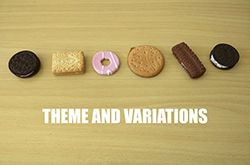Sectional Variations

- General:
- Usually identified by the title "Theme and Variations"
- This form becomes more prevalent in the Classical period, but earlier
examples do exist.
- The Theme:
- The theme is a closed form, either some periodic structure or a small-part
form.
- Often times the theme is in binary or rounded binary form.
- The theme usually has a very clear melodic idea, with easily recognizable
melodic and rhythmic motives, usually not very complex.
- Based on a relatively clear harmonic plan
- The Variations:
- Each variation typically alters only a limited number of the theme's
basic parameters.
- The variations often get more complex as the composition progresses.
- Elements most likely to be retained in each variation:
- Form
- Basic key plan
- Basic harmonic structure
- Structural melodic pitches
- Elements most likely to change radically from variation to variation:
- Texture
- Melodic figuration
- Elements most likely to see occasional change:
- Meter
- Tempo
- Surface harmonic progression
- Mode
- Analytical Considerations:
- Study the theme carefully. What is it's form? What melodic and rhythmic
characteristics are important?
- Are there any aspects of the motives, rhythm, harmonic rhythm, etc.,
that play an important role as the variations proceed?
- How do the motives in each variation relate to the theme?
- Is each variation fixed melodically, harmonically, or both?
- Does the key or mode change in any variation? If so, how does it affect
the overall structure?
- What is the overall shape of the composition? Are there any linking
passages between variations? Are the variations grouped based on melodic,
rhythmic, textural, or some other elements?

